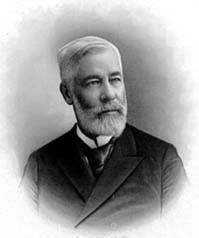
Magazine
Of Crinoids, Caverns, and Christianity
![]()

![]() he "father
of modern American cave exploration" was a Wabash man.
he "father
of modern American cave exploration" was a Wabash man.
"Many things beyond our comprehension are worthy of patient and prolonged
investigation."
When Horace C. Hovey, Wabash College class of 1853, summed up his philosophy with those words, he could have applied them either to his vocation as a Presbyterian minister--or his avocation--as the "father of American cave exploration," an explorer and author whom speleologists still refer to "unmatched as a popularizer of American caves."
Those who knew Horace's parents were hardly surprised when the boy developed an interest in rocks and caves and grew up to write engagingly and prolifically about his explorations. His father was Wabash College founder Edmund O. Hovey, an educator and pioneer preacher who so enjoyed and excelled in geology that he established a department of science at the College. His mother, Mary, had written with a powerful awareness of her surroundings detailed descriptions of the plant and animal life she observed in the wilderness of Indiana.
Horace began his geological discoveries early in life. At age nine he brought his father what he believed to be a petrified toad. His father realized the gift was a crinoid--a fossil of a marine invertebrate commonly known as a sea lily. After discovering hundreds more of these fossils on the same acreage, the senior Hovey bought the land where Horace had discovered the artifact. The Corey's Bluff Crinoid Beds became well-known as specimens and were displayed at the Smithsonian Institution, the American Museum of Natural History, and in many private collections.
One of Horace's early tasks as a young scientist was helping his father catalog 10,000 of these specimens which later became part of the College's Natural History Museum. But exploring was his preference, and he prowled the caves of southern Indiana not only for fun, but for profit as well, selling specimens and writing stories. In 1854 he joined an expedition to explore Wyandotte Cave and became the first person to map those caverns. In 1876, he visited Mammoth Cave in Kentucky as a correspondent for Scribner's magazine, and in 1878 Scientific American sent him to the newly discovered Luray Caverns of Virginia. Soon after he wrote the articles on American caves for the Encyclopedia Brittanica and finished the first edition of Celebrated American Caverns, the book that the Director of the Western Speleological Survey calls "a classic in Americana as well as in speleology." So popular was the book that a second printing was required in 1896, and so enduring was the volume that a third reprint was run in 1970.
Hovey explored and visited hundreds of caverns around the world during his lifetime-his companions often included dignitaries, such as the Czar of Russia-and he was frequently accompanied by an artist who would sketch the caves for books or articles. The following passage, penned by Hovey after documenting Sibert's Cave in Virginia with a sketch artist, captures the adventure and beauty of the underground world that kept calling the minister back from the pulpit and into the earth:
...a misstep would be fatal. Midway we clamber over a smooth, wet stalagmite The level gallery above can only be gained by laboriously climbing up a treacherous slope. As this offers nothing to be grasped as a safeguard against sliding into the abyss, nicks have been cut to afford foot-hold in the precarious passage. The risk is compensated for by admission into a wilderness of beauty and grandeur.
We wander on, beneath a ceiling fretted with glistening pendants, amid pillars and pilasters, flying-buttresses and interlacing arches. This gallery of marvels ends in the Peri's Prison, an exquisite grot, not more than five feet deep, crossed by a row of pillarets, like the bars of a cage. Red-fire burned within this dainty cavity produces a magical effect, throwing roseate hues over the fantastic and snowy piles.
Slowly returning to the pit, we find it more gloomy than ever. But there is no other exit. Steadying myself for a moment on the brink, I turn my face downward and search with the right foot for the first little notch, barely big enough for the toe of my boot. Then, letting go with one hand, the other holding the torch, and cautiously lower my left foot to the next notch. Step by step the narrow shelf is gained, beyond which, balancing like an acrobat, I move along on the perilous ridge between the chasms to a place of safety. Looking back to see how it fares with my artistic comrade, I behold him coolly sketching my underground gymnastics!
